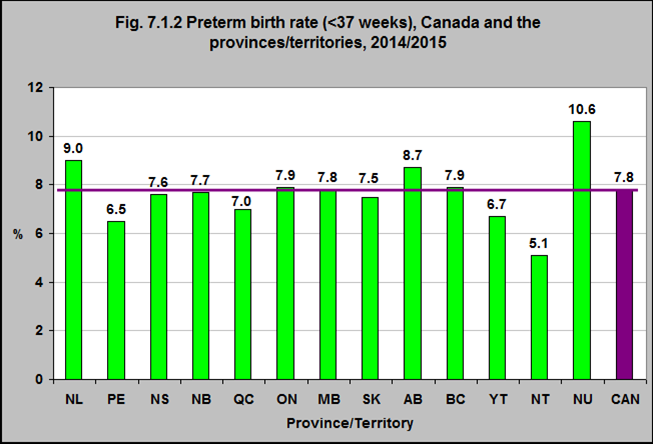Preterm birth rate (<37 weeks), Canada and the provinces/territories, 2014/2015

Note:
Live births with a gestational age less than 37 weeks expressed as a percentage of all live births (gestational age known).
Source: CICH graphic created using data adapted from the Discharge Abstract Database (DAD) Hospital Morbidity Database (HMDB), Canadian Institute for Health Information; and Fichier des hospitalisations MED-ECHO, ministere de la Sante et des Services sociaux du Quebec. https://apps.cihi.ca/mstrapp/asp/Main.aspx?Server=apmstrextprd_i&project=Quick%20Stats&uid=pce_pub_en&pwd=&evt=2048001&visualizationMode=0&documentID=029DB170438205AEBCC75B8673CCE822 – accessed June 20, 2017
In 2014/15, the preterm birth rate in Canada was 7.8%. The national rate has been stable since 2010/11 but rates vary between the provinces and territories.1
It was 10.6% in Nunavut, 5.1% in The Northwest Territories, and 6.5% in Prince Edward Island.
1Discharge Abstract Database (DAD) Hospital Morbidity Database (HMDB), Canadian Institute for Health Information; and Fichier des hospitalisations MED-ECHO, ministere de la Sante et des Services sociaux du Quebec. https://apps.cihi.ca/mstrapp/asp/Main.aspx?Server=apmstrextprd_i&project=Quick%20Stats&uid=pce_pub_en&pwd=&evt=2048001&visualizationMode=0&documentID=029DB170438205AEBCC75B8673CCE822– accessed June 20, 2017
Implications
Babies who are born preterm are at higher risk of many negative health outcomes. These include problems with the respiratory system such as respiratory distress syndrome and chronic lung disease; heart problems; hearing and vision problems; a compromised immune system and gastrointestinal problems. They are at a higher risk of dying. Preterm infants have a high rate of neurological problems – including cerebral palsy, developmental delay, learning disabilities, attention deficit-hyperactivity disorder, behavioural problems and social and emotional challenges. Babies who are born too early require access to services such as neonatal intensive care, follow-up programs and early intervention programs to address neurological deficits.1Provinces and territories need to have programs and services in place to support babies who are born preterm.1
1Institute of Medicine (US) Committee on Understanding Premature Birth and Assuring Healthy Outcomes; Behrman RE, Butler AS, editors. Preterm Birth: Causes, Consequences, and Prevention. Washington (DC): National Academies Press (US); 2007. https://www.ncbi.nlm.nih.gov/books/NBK11362/ -accessed August 31, 2017.
